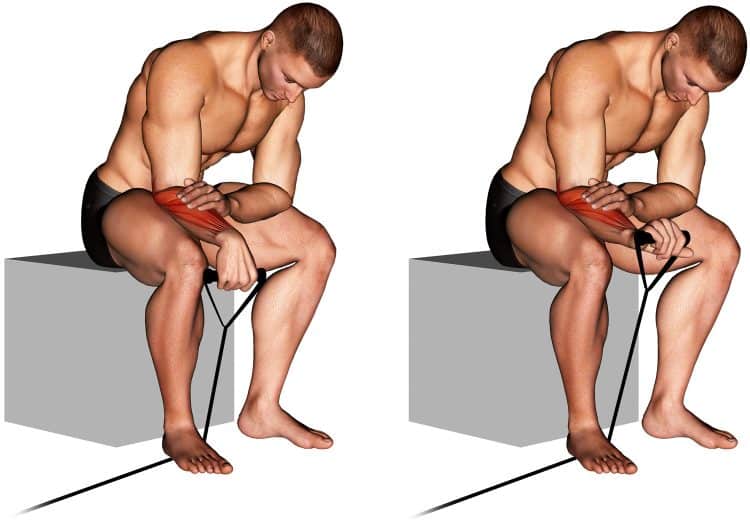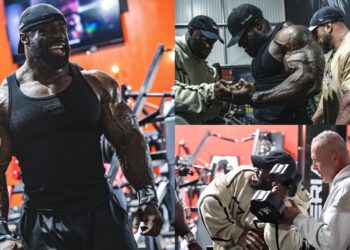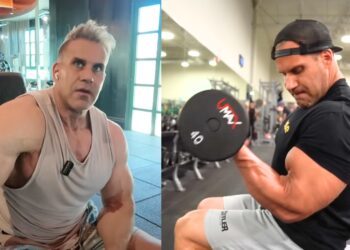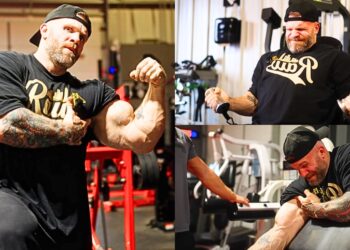Unless you have the Popeye gene (Sadly most of us don’t), you probably need to train your forearms (Oh the tragedy). For many, the forearm muscles, like those bastard calves need real convincing to get growing, which is where the band reverse wrist curl comes in. Giving the brachioradialis muscle in the lower arm special attention should yield hypertrophic gains and aesthetic benefits too.
Using a band offers some unique advantages over weights and cables. Like less stress on the wrists if using a full range of motion thanks to the stretch that scales with our natural strength curve, a cheap home training alternative, freedom of movement, and more.
Check out out complete band reverse wrist curl guide below.
How To Do Band Reverse Wrist Curls
While there’s a general technique when it comes to band reverse wrist curls, it’s perfectly okay and even recommended to adjust as needed. You should feel comfortable, pain-free, and most importantly, the best contraction in your brachioradialis.
The following step by step instructions explain the general idea of a seated band reverse wrist curl. Use the other information in this article to tailor your technique for best performance.
Steps
- Sit at the edge of a bench, chair, stool, etc.
- Hold the end of your band in either hand, then wrap the other part of the band under the same side foot, and anchor it down firmly.
- Rest your forearm on the thigh, and let the wrist hang off the edge of your knee or in between both legs. The arm should be slightly angled so that the wrist is lower than the forearm. From here, you may need to adjust your band’s length for optimal resistance. Make the band short enough so that it has tension before you even pull it up.
- Now curl your wrist up and back as far as you can. You should feel a contraction in the brachioradialis.
- Slowly reverse the motion, and repeat until you’re satisfied.
Here’s how it should look in motion!
Level Up Your Fitness: Join our 💪 strong community in Fitness Volt Newsletter. Get daily inspiration, expert-backed workouts, nutrition tips, the latest in strength sports, and the support you need to reach your goals. Subscribe for free!
Here’s a more detailed demonstration and explanation of how to do reverse wrist curls.
Tips
- Many prefer how a thumbless grip feels, only wrapping the four fingers around the handle or band.
- Avoid using momentum, and lower the resistance if needed.
Benefits of Band Reverse Wrist Curls
Where you might question the necessity of certain exercises, the band reverse wrist curl is not one. It’s beneficial, and if you’re consistent, it should make a difference in your arm development. Here are the advantages of including it in your forearm training.
Develop an important aesthetic muscle
The forearms are usually very visible, often sticking out of your short sleeve for the world to see. You know what that means? Your forearms need to represent for the rest of your physique, if you want people to see the hard work you put in your gym sessions.
Training the reverse technique will develop the part of your forearm that pops from the front or when viewed from the side.
Speed up tennis elbow recovery
As explained in the second video example above, wrist extensions aka reverse wrist curls are a good rehab exercise for tennis elbow. This condition causes pain around the elbow, and is often due to repetitive movement of the lower arm and wrists which strains the forearm muscles.
May be easier on the wrists than other variations
Thanks to the elastic nature of resistance bands, the first part of a rep is easier than the last. While this can be a drawback, unless you are skillful in band training, it’s not a bad thing in the band reverse wrist curl. If, in fact, you are using a full range of motion and flexing the wrist downward during the negative phase. Which feels more productive for some exercisers, as opposed to only training the top part of each rep.
Using a complete range of motion with dumbbells and barbells may place too much strain on the wrists since a free weight or cable maintains the same resistance during every aspect of a rep. And that can be challenging trying to get out of the hole (Wrist fully flexed downward before trying to lift it up).
If you know how to utilize bands, you can adjust them to create the right amount of tension that’ll benefit the muscles, and the wrist joint.
Common Mistakes During Band Reverse Wrist Curls
You need to be aware of what you’re doing with your bands. Don’t think they’re an easy training tool because you could waste your time if you don’t understand how to use them. Check out these common band reverse wrist curl bad habits to avoid.
Having too much slack
Referring to the starting position, there shouldn’t be slack or looseness in the bands. Anytime you train with bands, unless for a very specific reason, there should always be tension in the rubber at the start of an exercise upon initially contracting the target muscle. Otherwise you’re not maximizing the muscle’s potential and strength performance.
When it’s way too easy
If you can easily bang out 30 plus reps without breaking a sweat, then we suggest using more resistance. At this point, you’re doing a cardio workout and your muscles are not being challenged. The general purpose of resistance training is to create a growth/strength stimulus with progressive adaptation, or where the muscle needs to get bigger and stronger to handle the increasing training demands.
While you should never use maximal loads during wrist curls, to protect your joints, aim for 12-20 reps that challenge you near the last few repetitions of each set.
Overloading
Not only can you strain the wrists but the elbow will suffer from using too much resistance during forearm curls, especially if the arm is bent during the movement. If you want to load a little heavier, go with the straight arm modification that way the weight is fairly distributed through the arm,.
Level Up Your Fitness: Join our 💪 strong community in Fitness Volt Newsletter. Get daily inspiration, expert-backed workouts, nutrition tips, the latest in strength sports, and the support you need to reach your goals. Subscribe for free!
Variations and Alternatives of Band Reverse Wrist Curls
Here are some band reverse wrist curl variations and alternatives that should offer you every way to train your brachioradialis muscles.
Standing band reverse wrist curl
We’d put this variation above the seated band reverse wrist curl just because it’s simpler, and easier. When you stand on the band with both feet, you can more easily measure the ends to ensure they’re the same length. Not to mention, you can train both forearms at the same time.
Oh, and you can do this one a few different ways. With the arms bent at a 90-degree angle (Like halfway between a biceps curl), or the arms extended in front of you, which limits the motion but is good on the wrists.
Band hammer wrist curl
To emphasize more of the lateral forearm between the knuckles and palms, use a neutral or hammer grip. You can either grab the rubber part of the band or turn the handle vertically. Hammer wrist curls entail a shorter motion, but still use the same precautions. Don’t overload but challenge yourself.
Band wrist curl
The opposite of a reverse wrist curl, this version works the forearm flexors on the palm side of the lower arm. Actually this is the most common wrist curl variation because it’s generally how people flex and use their forearms muscles (i.e, curls, pulls, flexing the biceps, etc). We’re also typically naturally stronger when curling with grip.
You can setup similar to the band reverse wrist curl, or concentration curl where the back part of your arm is straight and pressed up against the inner thigh.
Check out these other wrist curls variations.
Band reverse curl
If you want to hit the biceps, brachialis, and brachioradialis all in one, then just do a reverse curl. Plus it’s a way to mix up your variations and prevent getting bored with your curls.
Free weight reverse wrist curl
A dumbbell or small fixed barbell can work for this exercise too. In fact, these are probably the most commonly used tools for wrist curl variations. But there are some terms and conditions, at least if you want to save your wrists.
Things to remember when using free weights:
- The weight should not be so heavy that you struggle to lift it up. Straining the wrists in the first half of the rep can be damaging to the wrists.
- If using a heavier weight, consider performing reps only in the top half range of movement so the hand doesn’t drop below the level of your forearm.
- Never use max loads with free weight variations. Keep your reps in the 12-25 range.
Muscles Worked
There’s no confusion about the muscles we’re trying to work here. Let’s go into detail about the anatomy and purpose of band reverse curls.
Brachioradialis
Brachio what? Okay, so you may have never heard of this muscle. Overshadowed by terms like ‘bicep’, and ‘triceps’, etc, the brachioradialis is a significant lower arm muscle both functionally and aesthetically. This muscle is on the front and lateral side of the forearm. It’s most visible when the arm is flexed and has a length half that of the forearm between the wrist and elbow crease.
What does it do?
The brachioradialis flexes the elbow where the forearm meets the biceps regardless of whether the palm is facing up or down. Its other job is to rotate the forearm in either direction.
Wrist extensors
These are muscles that extend the wrists and fingers. They are important although not superficial like the brachioradialis.
FAQ’s
What's the optimal sets and reps for band reverse wrist curls?
This one’s a little trickier since we’re talking about the wrists in an unsupported position. A rather small part of the body, we have to be careful about the loads placed on this joint when it’s curling and flexing it. Especially if you’re a smaller framed person or knowingly have weaker wrists.
In our opinion, a healthy, effective wrist curl should take effort without straining or needing to use momentum. This places you in the sweet spot of challenging resistance and avoiding wrist issues.
Aim for 2-4 sets x 12-25 reps where you have to work a little for the last few reps.
What's the best resistance band for forearm training?
The type of band doesn’t matter. What’s more important is the comfort and resistance. You can make any band work by adjusting its length to offer more or resistance.
So whether you have a looped or traditional double grip band, both are great choices.
Who should not do band reverse wrist curls?
If you have weak wrists, or prior wrist injuries then exercise caution to avoid further issues.
Wrapping Up
Band reverse wrist curls are an accessible and convenient way to stay on top of your forearm training. These stubborn little lower arm muscles may need to be babied more than your other body parts, and increased workout frequency is a popular training principle for bringing up lagging body parts.
Therefore, if you really want to bring out the brachioradialis, incorporate some dedicated reverse wrist curl sets until you see improvements. And don’t forget heavy pulls and curls, in general, which will maximize your arm development!
Interested in measuring your progress? Check out our strength standards for Wrist Curl, Reverse Wrist Curl.









